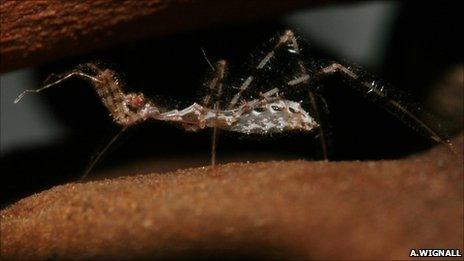Assassin bug lures spiders by mimicking prey
- Published

The assassin bugs' behaviour is known as aggressive mimicry, say the authors
Scientists have described how a species of insect lures spiders by mimicking prey caught in webs.
Assassin bugs plucked the web's silk threads that replicate the vibrations of a fly or other insect, causing the fooled spider to head towards the bug.
Once within reach, the bug slowly tapped the spider with its antennae before lunging and stabbing the lured arachnid with its sharp snout.
The findings appear, external in the journal Proceedings of the Royal Society B.
The team from Macquarie University, Australia, said the behaviour - known as aggressive mimicry - was one of two strategies employed by the bug (Stenolemus bituberus) to trap its prey.
The other involved "stalking" spiders, where the assassin bug slowly approaches the unsuspecting victim until within striking range.
The researchers, Drs Anne Wignall and Phil Taylor, explained that the bug exploited web-building spiders' use of vibrations to detect and locate its prey.
"However, reliance on vibratory cues and predictable responses leaves web-building spiders vulnerable to predators that aggressively mimic prey stimuli to gain control over their behaviour," they wrote.
"If you imagine an insect such as a fly when first hits the web, it'll generate a huge intial vibration, and then it will begin struggling violently, buzzing its wings," explained Dr Wignall.
"During these first vibrations, the risk of the prey escaping from the web is largest, and so spiders will tend to move in quickly on prey producing these sorts of vibrations in the web.
"But, as time goes on, an insect may get more tired, and the vibrations it produces will be much smaller. The spider can take more time approaching these insects as it's less likely to escape from the web," she told BBC News.
"These are the sorts of vibrations assassin bugs are mimicking, and it makes sense as a spider is very dangerous prey for a bug. If the spider approaches too fast, the risk to the assassin bug is much higher."
The assassin bugs, distributed throughout Australia, are often found on tree trunks, in both suburban and bush areas.
The insects live for about a year, and spend all their lives in spider webs - feeding, resting, mating. If they're not in a spider web, then they're usually travelling toward another spider web.
Bad vibes
Dr Wignall said the bugs' choice of the hunting strategy depended largely on the species of spider.
"Some species of spider, such as those from the genus Achaearanea (that build messy, three-dimensional tangle webs) are much more likely to be lured using aggressive mimicry than any of the other spiders we've tested."
The researchers say the study is the first to experimentally demonstrated that the spider-eating insects use mimicry to lure the spiders within range.
In their tests, the pair set out to compare the responses of spiders to the presence of prey in their webs with the arachnids' response to the assassin bugs' behaviour.
"Other vibrations in spider webs include mates and debris, and these were potential models for aggressive mimicry," they observed.
"Hence, we also compared spider behaviour in response to courting males and leaves falling into the web."
In their results, the team noted that there were "significant differences" to the various sources of vibrations.
They found that the spiders did not tend to respond to leaves falling on the webs, and female spiders responded to males by "entering a characteristic copulatory position".
But how spiders responded to the bugs was extremely similar to how the spiders responded to prey, they observed.
"To a spider, the vibrations generated by bugs resemble small or exhausted prey.
"The responses of spiders to prey in the web were occasionally characterised by a direct and rapid approach towards prey without pause (reaching it within one second)."
But, they explained: "This response was.. observed towards bugs or other sources, and may be elicited by the presence of higher frequency and amplitude vibrations in the struggles of prey."
However, spiders can be a formidable opponent for the assassin bug if they move quickly across the web to the potential predator.
"We have observed bugs being counter-attacked, killed and eaten by the spider they were hunting," they added. "This risk may be considerably increased when the spider approaches rapidly and without pause.
"Bugs, hence, appear to aggressively mimic a broad class of prey-like vibrations that are effective at soliciting approaches but are also unlikely to elicit highly aggressive, dangerous responses."